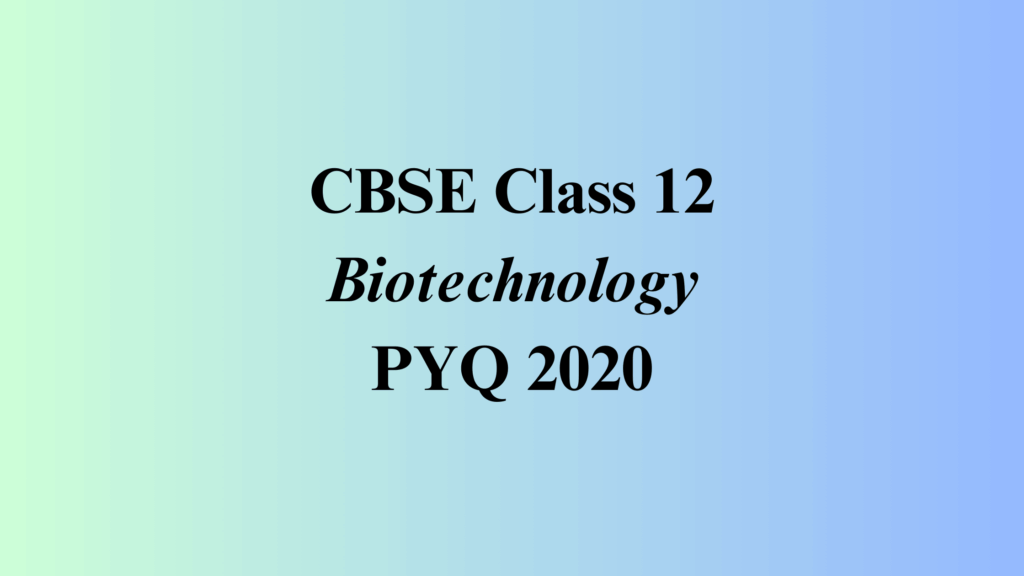Class 12 Biotechnology PYQ 2020 Solved
Time allowed: 3 hours
Maximum Marks: 70
SECTION A
1. Why is agar added to the culture medium used for culturing microbes? 1
Agar is added to the culture medium as a solidifying agent, providing a stable surface for microbial growth. It is not metabolized by most microbes, ensuring consistent medium properties.
2. Pectinase enzyme is needed to isolate single cells from a plant tissue. Why? 1
Pectinase breaks down pectin, a component of the plant cell wall, helping to separate individual plant cells for further studies or culture.
OR
For genetic transformation vector, which two DNA sequences are cloned in the T-DNA region of Ti-plasmid in place of unwanted DNA sequences? 1
The selectable marker gene and the gene of interest are cloned in the T-DNA region to facilitate plant transformation.
3. Give an example of a disease caused by the absence of the enzyme adenosine deaminase. 1
Severe Combined Immunodeficiency (SCID) is caused by the absence of adenosine deaminase.
OR
What is the cause of thalassemia? 1
Thalassemia is caused by mutations in the genes responsible for the production of hemoglobin, leading to reduced or defective hemoglobin synthesis.
4. In recombinant DNA technology, what is an ‘insert’? 1
An insert is a foreign DNA fragment introduced into a vector for cloning or expression in a host organism.
5. Which database retrieval tool carries information on the taxonomic classification of an organism? 1
The Entrez Taxonomy database (by NCBI) provides taxonomic classification information.
OR
Name a single gene mutation in humans which follows Mendelian inheritance, having chromosome 7 as its genomic location. 1
Cystic fibrosis is caused by a mutation in the CFTR gene located on chromosome 7.
6. Frozen animal cell culture should be thawed in a water-bath maintained at 37 °C, with moderate shaking. Why? 1
Thawing at 37°C prevents ice crystal formation, which can damage the cells, and moderate shaking ensures even thawing.
7. What are the 2 limitations of germplasm conservation through conventional methods? 1
(i) Genetic erosion due to environmental conditions.
(ii) Limited viability over long periods.
8. Polyethylene glycol is a 1
- (A) Fusogenic chemical
- (B) Callus stimulant
- (C) Electrofusion stimulant
- (D) Differentiation stimulant
9. Which one of the following restriction enzymes produces blunt ends in a DNA fragment? 1
- (A) Alu I
- (B) Eco RI
- (C) Bam HI
- (D) Hind III
10. The study of full complement of proteins expressed by a genome is called 1
- (A) Proteome
- (B) Proteomics
- (C) Genomics
- (D) Protein analysis
11. Which of the following is a function of cryoprotective agents ? 1
- (A) Long-term preservation of cultures
- (B) Prevention of cell damage due to ice crystal formation
- (C) Prevent formation of inclusion bodies
- (D) To trap the liquid nitrogen
Question numbers 12(i) to 12(iv) are based on the following text :
12. The culturing of animal cells under in-vitro conditions involves appropriate physical, nutritional, and hormonal environments. The physical environment includes controlling the temperature maintained at 37C, pH around 7 – 7·4, osmolality, and gaseous environment by providing a supporting surface and protecting the cells from physical, chemical, and mechanical stress. 1+1+1+1
(i) Name the type of culture which is prepared by inoculating directly from the tissue of an organism to the medium of culture.
- (A) Secondary cell line
- (B) Cell line
- (C) Primary cell culture
- (D) Transformed cell culture
(ii) pH of culture (animal cell) medium is controlled by
- (A) Presence of CO2
- (B) Presence of bicarbonate buffer
- (C) Addition of bases
- (D) Addition of citric acid
(iii) Major contributors to osmolality of medium for animal cell culture are
- (A) Salt and glucose
- (B) Serum and antibiotics
- (C) Sodium bicarbonate and CO2
- (D) Phenol red and trypan blue
(iv) Disaggregation of cells for cell culture can be achieved by the enzyme
- (A) Trypsin
- (B) Collagenase
- (C) Chymotrypsin
- (D) Both (A) and (B)
SECTION B
13. Differentiate between Batch and Fed-Batch culture. 2
- Batch culture: Nutrients are added at the beginning, and no further addition occurs. Growth continues until nutrients are exhausted.
- Fed-batch culture: Nutrients are added periodically to maintain growth and increase product yield.
14. Differentiate between Paralogous and Homologous DNA sequences. 2
- Paralogous DNA sequences: Genes that arise from gene duplication within the same organism and may evolve different functions.
- Homologous DNA sequences: Genes that share a common ancestor, including both paralogs (within species) and orthologs (between species).
15. Why do the scientists artificially infect the plants with Agrobacterium rhizogenes ? 2
Agrobacterium rhizogenes is used for genetic transformation because it induces the formation of hairy roots, which can be utilized for secondary metabolite production and genetic studies.
16. r-HuEPO has advantages over blood transfusion. List any two of them. 2
- (i) r-HuEPO (Recombinant Human Erythropoietin) reduces the risk of infections that may be transmitted through blood transfusion.
- (ii) It provides a controlled and sustained production of red blood cells without the need for repeated transfusions.
17. Calculate the generation time of a bacterial population in which the number of bacteria increases from 104/mL to 107/mL during four hours of exponential growth. 2
- Generation time (g) = (t × log 2) / (log Nt – log N0)
- t = 4 hours, Nt = 10⁷, N0 = 10⁴
- g ≈ 48 minutes
18. A recombinant vaccine is prepared using the selected epitopes of a given protein. What are the advantages of doing so ? 2
- (i) It reduces the risk of infection since only parts of the pathogen are used.
- (ii) It enhances immune response specificity by focusing on protective antigens.
OR
‘Molecular pharming’ has advantages of producing recombinant protein in milk as compared to microbial fermentation. Write any two advantages. 2
(i) Higher yield of recombinant proteins in milk.
(ii) Post-translational modifications in milk-producing animals are more similar to humans than in microbes.
19. How does Restriction Modification system work as a defense system in bacteria ? 2
The restriction enzyme cuts foreign DNA at specific sites, while the modification enzyme methylates the host DNA to protect it from degradation.
OR
Give the function of these enzymes in cloning: 2
DNA ligase and alkaline phosphatase
- DNA ligase: Joins DNA fragments by forming phosphodiester bonds.
- Alkaline phosphatase: Removes phosphate groups to prevent self-ligation of vectors during cloning.
SECTION C
20. Give reasons for the following : 3
- (a) Cos sites or cohesive sites of bacteriophage lambda should not be replaced by the insert DNA.
- (b) Expression vectors are preferred if the foreign protein has to be produced in the host.
- (c) Yeast is a preferred host for the expression of eukaryotic genes.
- Cos sites are necessary for packaging lambda DNA into phage heads during viral replication.
- Expression vectors contain regulatory elements for high-level protein production.
- Yeast provides proper protein folding and post-translational modifications similar to higher eukaryotes.
21. With an example, describe a technique which can be used to compare the peptides of a similar protein from different sources. 3
2D Gel Electrophoresis: Separates proteins based on isoelectric point and molecular weight, allowing comparison of protein expression patterns across sources.
22. (a) Complete (Identify A, B, C, D, E) the comparison of Human communication language with Biological Language.
Human Communication Language Biological Language
Alphabet A
Words B
C Operons
D Turns, Kinks, Bends
Chapter E
(b) In which field of science is this biological language used? 3
- A: Nucleotides
- B: Codons
- C: Genes
- D: Alpha helices & Beta sheets
- E: Genome
(b) Bioinformatics and Molecular Biology
OR
What kind of analysis can be carried out using Bioinformatics tools? 3
- (i) DNA and protein sequence analysis
- (ii) Phylogenetic analysis
- (iii) Drug discovery
23. What were the observations made by Margaret O. Dayhoff while studying the variations in protein sequence during evolution? 3
- (i) Conserved regions of proteins indicate evolutionary relationships.
- (ii) Substitutions occur more frequently at variable sites.
- (iii) Mutations in functionally important sites are rare.
24. A typical purification scheme of a desired protein is shown :
| Procedure | Total Protein(mg) | Activity (units) | Specific Activity (units/mg) | |
| (i) | Crude extract | 20,000 | 40,00,000 | 200 |
| (ii) | Precipitation | 5,000 | 30,00,000 | 600 |
| (iii) | Ion-Exchange Chromatography | 200 | 8,00,000 | 4,000 |
| (iv) | Affinity Chromatography | 150 | 7,50,000 | 4,000 |
(a) Which step of purification is of least importance and why?
(b) Why does the total amount of protein decrease with each step of the purification procedure? 3
- (a) Precipitation step is of least importance because it has the lowest purification efficiency.
- (b) Total protein decreases as impurities are removed, concentrating only the desired protein.
25. PHB (Polyhydroxybutyrate) production in bacteria has many drawbacks. Why? Give one reason. How has genetically engineered Arabidopsis solved this problem? 3
- (i) Drawback: High production costs and limited bacterial growth conditions.
- (ii) Solution: Genetically engineered Arabidopsis produces PHB in plant tissues, reducing costs.
OR
(a) How is ‘Golden Rice’ developed?
(b) Name any one scientist involved with the development of ‘Golden Rice’. 3
- By inserting genes for β-carotene biosynthesis from daffodils and bacteria into rice.
- Ingo Potrykus
26. Read the sequence from the gel, obtained by dideoxy nucleotide chain termination method. Write the sequence of the original DNA strand. Also show the cuts produced in the obtained sequence by subjecting the obtained sequence to digestion by EcoRI enzyme. 3
The original DNA sequence is determined by reading the gel from bottom to top.
EcoRI digestion cuts at the recognition site GAATTC.
SECTION D
27. (a) What is Restriction Fragment Length Polymorphism (RFLP)?
(b) Which two individuals can have the same RFLP pattern?
(c) Give two applications of RFLP.
(d) Why are Restriction Enzyme type II used in recombinant DNA technology and in RFLP generation? 5
- (a) RFLP is a technique used to detect variations in DNA sequences.
- (b) Identical twins can have the same RFLP pattern.
- (c) Applications: (i) DNA fingerprinting, (ii) Genetic disease diagnosis.
- (d) Type II restriction enzymes are used because they cut at specific recognition sites.
28. (a) What is a callus? Callus culture is of great significance in plant tissue culture. Justify, giving two applications.
(b) How are cybrids produced?
(c) Endosperm culture has a great commercial significance. How? 1+2+1+1=5
- A callus is a mass of undifferentiated plant cells used for genetic transformation and regeneration.
- By fusing protoplasts from different species.
- Production of triploid plants for seedless fruit varieties.
OR
(a) Define the term ‘totipotency’.
(b) List four major steps in the process of micropropagation. 1+4=5
- The ability of a single cell to develop into a complete organism.
- Four steps of micropropagation: (i) Explant selection, (ii) Callus induction, (iii) Shoot and root differentiation, (iv) Hardening and transfer to the field.
29. (a) What is a Metagenome?
(b) Describe the procedure of developing a metagenome.
(c) Give the importance of Metagenomics approach. 5
- (a) Metagenome is the total genetic material of a microbial community.
- (b) Developing a metagenome involves DNA extraction, sequencing, and computational analysis.
- (c) Importance: Discovery of novel enzymes and antibiotic resistance genes.
OR
(a) What are the main considerations for safety aspects, specific to microbial biotechnology?
(b) State the role of microbial culture collection centres.
(c) Lyophilized cultures of microbes remain viable for several years. Why ? 5
- (a) Avoiding pathogen release and preventing antibiotic resistance spread.
- (b) Preserve and distribute microbial strains for research.
- (c) Water removal prevents microbial degradation.
30. Give reason for the following: 5
(a) Van der Waals forces are weak forces but still play a significant role in determining the 3-D structure of biomolecules.
(b) Strength of ionic bond is reduced in water.
(c) Sickle shape of RBCs are responsible for anemic condition of patients.
(d) Mass spectrometer is advantageous for sequencing of amino acids.
(e) Quarternary structure of proteins are multimeric in nature.
- (a) Van der Waals forces stabilize biomolecular structures.
- (b) Ionic bonds weaken in water due to hydration.
- (c) Sickled RBCs block blood flow, causing anemia.
- (d) Mass spectrometry provides accurate amino acid sequencing.
- (e) Quaternary protein structures are formed by multiple subunits.
Additional Study Materials
- Class 12 Biotechnology Syllabus 2025-26
- Class 12 Biotechnology Question Paper 2024
- Class 12 Biotechnology PYQ 2023 Solved
- Class 12 Biotechnology Question Paper 2022 Solved




